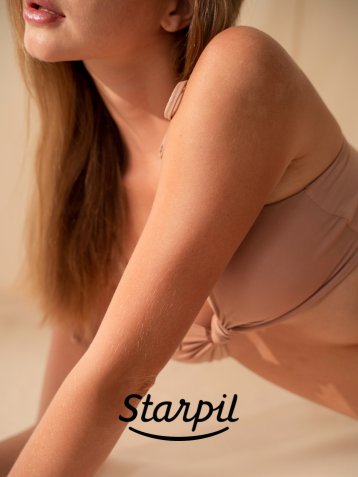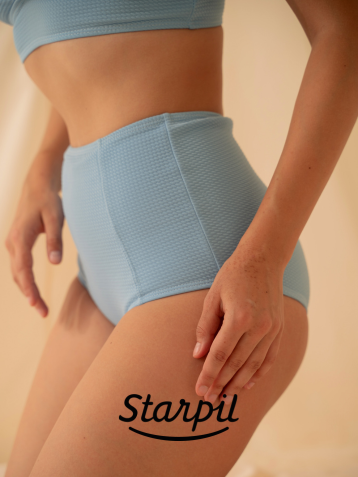Waxing with Eczema: How to Safely Wax Sensitive Skin

Living with eczema or sensitive skin doesn't mean you have to give up on waxing. With proper precautions, communication with your esthetician, and the right products, you can safely achieve smooth, hair-free skin.
Here's everything you need to know about navigating waxing services when you have sensitive skin or eczema.
READ: When to Exfoliate After Waxing

Can You Wax with Eczema?
First thing’s first: is it safe to wax when you have eczema? Yes, you can wax if you have eczema—but with important caveats. The key is timing and skin condition:
-
Waxing is possible during periods when your eczema is well-controlled
-
Never wax during active flare-ups or on broken skin
-
Some areas may be more suitable for waxing than others
-
Patch testing is essential before full treatments
-
Consulting with your dermatologist before starting a waxing routine is recommended
Your success with waxing will depend on:
-
The severity of your eczema
-
Your skin's current condition
-
The products used
-
Your esthetician's experience with sensitive skin
-
Your post-wax care routine
Understanding Your Skin's Needs
Before booking a waxing appointment or waxing on your own, it's important to understand how eczema and sensitive skin react to different stimuli. Eczema-prone skin tends to be:
-
More reactive to temperature changes
-
Easily irritated by certain ingredients
-
Prone to flare-ups caused by stress or environmental factors
-
Prone to inflammation
-
More susceptible to allergic reactions
-
Quick to show redness and irritation
These characteristics don't automatically disqualify you from waxing, but they do mean you'll need to take extra precautions and work with an experienced esthetician who understands sensitive skin concerns.

When to Skip Your Waxing Appointment
Safety comes first. You should postpone your waxing appointment if you're experiencing:
-
An active eczema flare-up
-
Open sores or broken skin
-
Severe inflammation or redness
-
Recent sun damage or sunburn
-
Any skin infection
-
Extreme dryness or scaling
-
Recent use of prescription retinoids or harsh exfoliants
Wait until your skin has completely healed and shows no signs of active irritation before scheduling your next appointment. Most estheticians recommend waiting at least 2-3 weeks after a flare-up subsides.
READ: Sugaring vs. Waxing: The Complete Guide
Should I Tell My Esthetician About My Eczema?
Open communication with your waxer is crucial for a safe and comfortable experience. You should always clearly communicate with your waxer regarding any existing skin conditions or sensitivities, including eczema, so they can best cater to your skin’s health and hair removal needs. Here's what to discuss:
Before Your Appointment:
-
Inform them about your eczema or sensitive skin condition
-
Mention any medications you're taking for your skin
-
Disclose the use of any retinoids
-
Discuss areas where you typically experience flare-ups
-
Ask about patch testing with waxes formulated for sensitive skin
-
Share what has and hasn't worked for you in the past
During Your Appointment:
-
Speak up if you experience unusual discomfort
-
Let them know if an area feels too sensitive
-
Ask questions about the products being used
-
Discuss post-wax care recommendations
READ: Waxing vs. Shaving: What is the Best Method for Hair Removal?

Preparing for Your Waxing Service
Taking the right steps before your appointment can significantly improve your experience:
-
Timing Is Everything:
-
Schedule appointments between flare-ups
-
Reschedule in the event of a flare-up
-
Book during morning hours when skin sensitivity is typically lower
-
Avoid scheduling during your menstrual cycle when skin is more sensitive
-
Skin Preparation:
-
Keep skin well-moisturized in the days leading up to your appointment
-
Gently exfoliate 24 hours before waxing
-
Consider taking an antihistamine 30 minutes before your appointment
-
Wear loose, comfortable clothing to your appointment
-
Product Considerations:
-
Ask your esthetician about formulas they use for sensitive skin, including:
-
Starpil Starsoft Hard Wax: Hypoallergenic and free from dyes, rosins, and perfumes, this wax soothes inflammation and irritation in even the most sensitive skin types while dulling pain and removing hair effectively.
-
Starpil Rosin-Free Pink Hard Wax: Created for reactive and sensitive skin types, this wax is formulated with titanium dioxide to nourish and ease delicate skin during hair removal.
-
Discuss any products you're currently using on your skin
During Your Waxing Service
A successful waxing service for sensitive skin involves:
-
Temperature Testing:
-
Always request a temperature test before beginning
-
Speak up if the wax feels too hot
-
Ask for a wax with a cooler application temperature if needed
-
Patch Testing:
-
Request a small patch test in a less sensitive area
-
Wait a few minutes to see how your skin reacts
-
Proceed only if no adverse reaction occurs
-
Taking Breaks:
-
Don't hesitate to ask for breaks between sections
-
Allow your skin to calm down if needed
READ: Can I Shower After Waxing?

Post-Wax Care for Sensitive Skin
Proper aftercare is crucial for preventing irritation:
-
Immediate Care:
-
Apply a Post-Wax Lotion and Post-Wax Oil formulated for sensitive skin
-
Avoid touching or scratching the waxed area
-
Keep the area clean and dry
-
The First 24-48 Hours:
-
Wear loose, breathable clothing
-
Avoid hot showers or baths
-
Skip the gym or any activity that causes sweating
-
Don't apply harsh products or exfoliants
-
Keep the area moisturized
-
Long-term Care:
-
Monitor your skin for any delayed reactions
-
Keep track of what works and what doesn't
-
Maintain a consistent skincare routine between appointments
-
Consider using an Ingrown Hair Serum or gentle exfoliant after 24 hours to prevent ingrown hairs
Remember, everyone's skin is different, and what works for one person may not work for another. It may take some time to find the perfect combination of products and techniques that work best for your sensitive skin.
READ: How to Prevent Pimples After Waxing
Final Thoughts
Living with eczema or sensitive skin requires extra care and attention when it comes to hair removal, but it doesn't mean you can't enjoy the benefits of waxing. By working closely with your esthetician, taking proper precautions, and maintaining good skin care habits, you can achieve smooth, hair-free skin safely and comfortably.




Comentarios